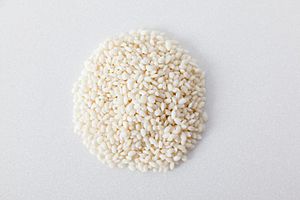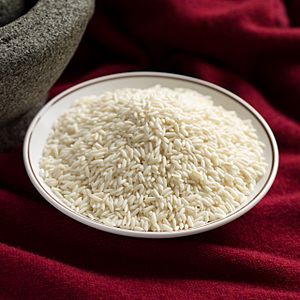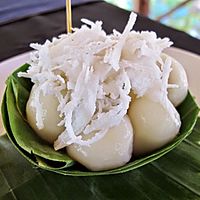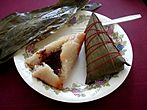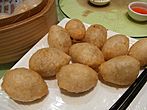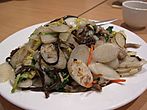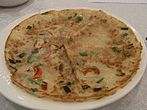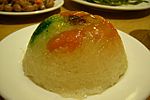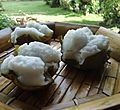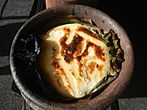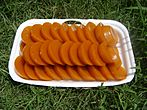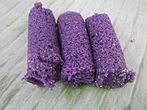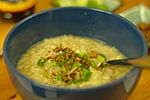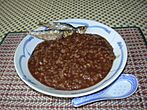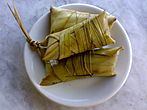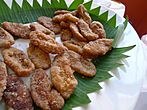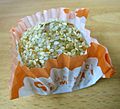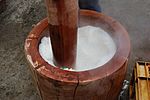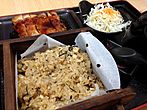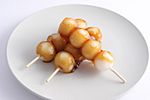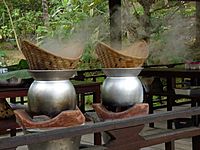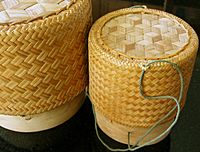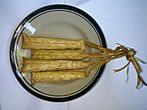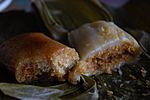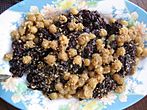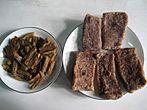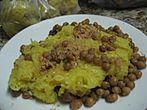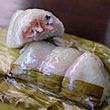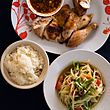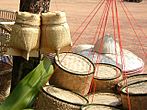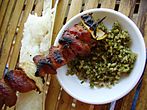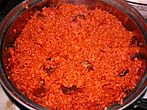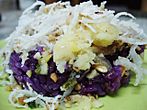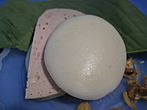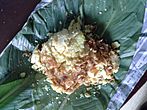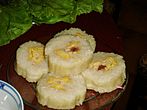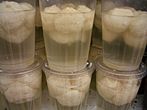Glutinous rice facts for kids
Glutinous rice (also called sticky rice, sweet rice or waxy rice) is a special kind of rice that grows mostly in Southeast and East Asia, and parts of South Asia. When cooked, its grains become very sticky. This is because it has almost no amylose, which is a part of starch, and lots of amylopectin, which makes it glue-like.
The name "glutinous" means "glue-like" or "sticky." It does not mean it contains gluten, which it doesn't. So, it's safe for people who need to avoid gluten. Even though other types of rice can be a bit sticky when cooked, glutinous rice is known for being extra sticky. There are many different kinds of glutinous rice plants grown around the world.
Contents
History of Sticky Rice
People in China have been growing glutinous rice for at least 2,000 years! Researchers believe that this special rice spread across Asia, especially with the Lao people as they moved south along the Mekong River.
Where Sticky Rice Grows
Glutinous rice is grown in many countries, including Laos, Thailand, Cambodia, Vietnam, Malaysia, Indonesia, Myanmar, Nepal, Bangladesh, Bhutan, Northeast India, China, Japan, Korea, Taiwan, and the Philippines.
In Laos, about 85% of all the rice grown is glutinous rice. It has been a part of their culture for at least 1,100 years! The International Rice Research Institute (IRRI) even calls Laos a "collector's paradise" because it has the most different kinds of sticky rice in the world. Over 13,500 samples and 3,200 types of sticky rice have been collected from Laos alone!
What Makes it Sticky?
Glutinous rice is different from other rice because it has almost no amylose and a lot of amylopectin. These are both types of starch. Amylopectin is what makes glutinous rice so sticky. This difference comes from a tiny change in the rice plant that farmers chose to grow long ago.
Just like all other types of rice, glutinous rice does not have dietary gluten. This means it's safe for people who follow a gluten-free diet.
Glutinous rice can be used with or without its outer layer (called the bran). When the bran is removed, it's white and looks solid, not see-through like other raw rice. If the bran is left on, the rice can be purple or black. These black and purple types are different from the white ones. Both white and colored glutinous rice can be cooked as separate grains or ground into flour to make pastes or gels.
How Sticky Rice is Used in Food
Sticky rice is a super important ingredient in many dishes across Southeast and East Asia. It's used in dumplings, as a side dish, mixed with beans, or even fried by itself to make rice cakes.
Bangladesh
In Bangladesh, especially in the Chittagong and Sylhet areas, sticky rice called bini dhan is very popular. People grow both white and pink types. Cooked sticky rice, called Bini Bhat, is a common breakfast. It's often served with fish or meat curry and grated coconut. Sometimes, it's eaten simply with sugar, salt, and coconut.
Many sweet treats are also made from bini choil (husked sticky rice):
- Atikka pita is a favorite. It's made with coconut, sugar, ripe bananas, and bini choil, wrapped in a banana leaf, and steamed.
- Patishapta pita uses ground bini choil to make a thin pancake filled with coconut, sugar, and milk powder.
- Laru are small balls or dumplings made from fried and ground bini choil mixed with sugar and butter.
Cambodia
In Cambodian cuisine, glutinous rice is called bay damnaeb. It's mostly used for desserts and is a key ingredient in many sweet dishes like ansom chek, kralan, and num ple aiy.
China
In China, glutinous rice is known as nuòmǐ. It's often ground into flour to make popular foods like niangao (a type of cake) and sweet-filled dumplings called tangyuan. Both are often eaten during Chinese New Year.
Other popular Chinese dishes made with glutinous rice include:
- Nuòmǐ fàn: Steamed glutinous rice cooked with Chinese sausage, mushrooms, barbecued pork, and sometimes dried shrimp.
- Zongzi: Dumplings made of glutinous rice and fillings (sweet or savory) wrapped in large leaves, then boiled or steamed. They are popular during the Dragon Boat Festival.
- Cifantuan: A breakfast food where a piece of fried dough (youtiao) is wrapped tightly in cooked glutinous rice.
- Lo mai gai: A dim sum dish with glutinous rice and chicken, steamed in a lotus leaf.
- Ba bao fan (Eight Treasure Rice): A dessert made from steamed glutinous rice mixed with sugar and eight kinds of fruits or nuts.
- Chinese glutinous rice dishes
-
Glutinous zongzi rice dumplings, without and with bamboo leaf wrapping
Philippines
In the Philippines, glutinous rice is called malagkit or pilit, both meaning "sticky." A common way to prepare it is by soaking the rice, then grinding it into a thick paste called galapóng. This paste is the base for many Filipino rice cakes.
Some popular Filipino dishes made with glutinous rice include:
- Puto: Steamed rice cakes.
- Bibingka: Baked rice cakes.
- Puto bumbong: Made with purple glutinous rice and steamed in bamboo tubes.
- Suman, biko, and sapin-sapin: Other types of rice cakes.
- Lugaw: Rice porridges. These can be savory, like arroz caldo (with chicken), or sweet, like champorado (with chocolate).
- Filipino glutinous rice dishes
-
Puto, steamed rice cakes made with fermented galapong
-
Bibingka, made from baked galapong with coconut milk
-
Puto bumbong, steamed rice cakes made with purple glutinous rice, steamed in bamboo tubes
-
Ginataang mais, a dessert lugaw (rice gruel) with coconut milk and sweet corn
-
Arroz caldo, savory lugaw with chicken, ginger, toasted garlic, scallions, and safflower
-
Champorado, dessert lugaw made from glutinous rice and chocolate
-
Suman sa ibus, a type of suman, steamed glutinous rice packaged in tagbak leaves
-
Moche, boiled glutinous rice filled with bean paste
-
Sapin-sapin, a colorful dessert made with multiple layers of glutinous rice, each with a different flavor and texture
-
Pusô, made from glutinous rice cooked in pouches of woven coconut leaves
-
Puto maya made with pirurutong rice
Indonesia
In Indonesia, glutinous rice is called beras ketan or ketan. It's often mixed with coconut milk and a little salt. It's usually not eaten as a main meal but as an ingredient in snacks.
Some Indonesian sticky rice snacks include:
- Lemang: Glutinous rice and coconut milk cooked inside bamboo stems.
- Lemper: Cooked glutinous rice with shredded meat, wrapped in banana leaves.
- Nasi kuning: Yellow rice, which can be made with glutinous rice and colored with turmeric.
- Bubur ketan hitam: Black glutinous rice porridge with coconut milk.
- Dodol: Traditional sweets made from glutinous rice flour and coconut sugar.
- Klepon: Glutinous rice flour balls filled with palm sugar and covered with grated coconut.
- Tapai ketan: Cooked glutinous rice fermented with yeast, often wrapped in banana leaves.
-
Lemper, glutinous rice filled with chicken wrapped in banana leaves
-
Dodol made from coconut sugar and ground glutinous rice
-
Bubur ketan hitam, black glutinous rice porridge with coconut milk and palm sugar
-
Ketan served with durian sauce
-
Kue lupis - Glutinous rice cake with grated coconut and liquid palm sugar
-
Tapai ketan (right) served with uli (glutinous rice cooked with grated coconut, and mashed; left)
Japan
- Japanese glutinous rice dishes
In Japan, glutinous rice is called mochigome. It's used in traditional dishes like sekihan (red bean rice) and okowa. It's also ground into mochiko (rice flour) to make mochi, which are sweet rice cakes. Mochi are a traditional treat for Japanese New Year and are often flavored with red beans, green tea, or pickled cherry flowers.
Korea
In Korea, glutinous rice is called chapssal. Its stickiness is called chalgi. Cooked glutinous rice is called chalbap, and rice cakes are called chalddeok or chapssalddeok. Chalbap is used to stuff samgyetang, a chicken soup.
Laos
Glutinous rice is the national dish of Laos! The Lao people have been growing it for thousands of years. They eat more sticky rice per person than anywhere else in the world. Sticky rice is a huge part of Lao culture, traditions, and national identity. Lao people often call themselves the "children of sticky rice."
Sticky rice is known as khao niao in Laos. It's cooked by soaking it for hours, then steaming it in a bamboo basket called a houat. After cooking, it's kneaded to release steam, making rice balls that stick to each other but not your fingers. These rice balls are kept in a small bamboo basket called a thip khao.
A popular Lao meal includes larb (a meat salad), grilled chicken (ping gai), spicy green papaya salad (tam mak hoong), and sticky rice (khao niao).
Other sticky rice dishes in Laos:
- Khao lam: Sticky rice mixed with coconut milk and beans, cooked inside bamboo tubes.
- Nam Khao: A crispy rice salad made with deep-fried sticky rice balls.
- Khao Khua: Toasted and crushed sticky rice, used to add a nutty flavor to dishes like larb.
- Khao tom: Steamed sticky rice with fruit and coconut milk, wrapped in a banana leaf.
Malaysia
- Malaysian glutinous rice dishes
In Malaysia, glutinous rice is called pulut. It's usually mixed with coconut milk and salt. It's very popular during the Raya festive seasons.
Some Malaysian sticky rice dishes include:
- Dodol: Traditional sweets made of glutinous rice flour and coconut sugar.
- Ketupat: Square-shaped rice cakes, usually filled with regular rice, but sometimes pulut.
- Lemang: Wrapped in banana leaves and cooked inside bamboo over an open fire.
- Pulut inti: Glutinous rice with grated coconut candied with palm sugar, wrapped in a pyramid shape.
- Pulut panggang: Sticky rice parcels with a spiced filling, grilled in banana leaves.
- Tapai: Cooked glutinous rice fermented with yeast.
Myanmar
Glutinous rice, called kao hnyin, is very popular in Myanmar (Burma).
- Kao hnyin baung: A breakfast dish with boiled peas or fritters, served on a banana leaf.
- kao hynin ngacheik: The purple variety of sticky rice, also popular for breakfast.
- Si htamin: Glutinous rice cooked with turmeric and onions in peanut oil, served with toasted sesame.
- Mont lone yay baw: Glutinous rice balls with jaggery inside, boiled until they float. These are a tradition during Thingyan, the Burmese New Year.
- Burmese glutinous rice dishes
-
Hkaw bouk - dried cakes of ngacheik glutinous rice with Bombay duck, both fried
-
Htamanè - glutinous rice with fried coconut, roasted peanuts, sesame and ginger
-
Si htamin - glutinous rice cooked in oil with turmeric and served with boiled peas and crushed salted sesame
-
Mont lone yei baw - glutinous rice balls filled with jaggery, covered with shredded coconut - a New Year treat
-
Paung din (ngacheik) with to hpu (Burmese tofu), mashed potato and black gram fritters
Nepal
In Nepal, a dish called Latte/Chamre, made from Glutinous Rice, is popular during the Teej festival, which is a big celebration for Nepalese women.
Northeastern India
Sticky rice, called bora saul, is a main ingredient in traditional sweets, snacks, and breakfasts in Assam. These sweets are very different from other Indian sweets, which usually use milk.
Some traditional Assamese sweets include Pitha (like Narikolor pitha, Til pitha, Ghila pitha). The rice powder is also eaten directly with milk for breakfast.
During religious ceremonies, people make Mithoi using sticky rice. Sometimes, Bhog and Payokh are also made with milk and sugar. Many local groups also make rice beer from sticky rice because it makes a sweeter and stronger drink.
Thailand
In Thailand, glutinous rice is known as khao niao (meaning 'sticky rice'). People in northern and northeastern Thailand traditionally eat glutinous rice as their main food. It's usually served in a small woven basket called a kratip khao.
Some popular Thai sticky rice dishes and uses:
- Khao niao mamuang: Sweet coconut sticky rice with fresh mango, very popular with tourists.
- Khao lam: Sticky rice with sugar and coconut cream, cooked inside bamboo sections.
- Khao chi: Sticky rice cakes, often coated with egg and grilled over charcoal.
- Khao khua: Roasted ground glutinous rice, used to add a nutty flavor to dishes like larb and nam tok.
- Khao tom mat: Cooked sticky rice mixed with banana, wrapped in a banana leaf and steamed.
- Sai krok Isan: Grilled, fermented pork sausages from northeastern Thailand, which use sticky rice in their making.
- Thai glutinous rice dishes
-
Kratip (Thai: กระติบ) are used by northern and northeastern Thais as containers for sticky rice
Vietnam
Glutinous rice is called gạo nếp in Vietnamese. Dishes made from it are usually desserts or side dishes, but some can be main meals.
Here are some types of Vietnamese glutinous rice dishes:
- Bánh: This is a very diverse group of cakes, buns, and pastries.
* Bánh chưng: A square-shaped, boiled glutinous rice dumpling filled with pork and mung bean paste, often eaten during Vietnamese New Year. * Bánh giầy: White, flat, round glutinous rice cake, often eaten with Vietnamese sausage. * Bánh rán: Deep-fried glutinous rice balls covered with sesame, filled with sweet mung bean paste or savory meat. * Bánh trôi: Glutinous rice balls filled with rock candy.
- Xôi: Sweet or savory dishes made from steamed glutinous rice and other ingredients. Sweet xôi is often eaten for breakfast, while savory xôi can be for lunch.
* Xôi gấc: Made with the red gấc fruit, giving it a bright orange color. * Xôi lá dứa: Made with pandan leaf extract for a green color and special flavor. * Xôi gà: Made with coconut juice and pandan leaf, served with fried or roasted chicken.
- Chè: Traditional Vietnamese sweetened soups or porridges.
* Chè đậu trắng: Made from glutinous rice and black-eyed peas. * Chè xôi nước: Glutinous rice flour balls filled with mung bean paste, served in a sweet ginger syrup.
- Cơm rượu: Glutinous rice balls cooked and mixed with yeast, served in a small amount of rice wine.
- Cơm lam: Glutinous rice cooked inside a bamboo tube, often served with grilled pork or chicken.
- Vietnamese glutinous rice dishes
-
Cơm lam, rice cooked in a bamboo tube
-
Xôi gấc, glutinous rice cooked with Gac fruit
-
Xôi gà or chicken xôi
-
Bánh giầy, pounded rice cake
-
Bánh chưng a savoury rice cake with mung beans and pork fillings, usually consumed during Tết
-
Cơm rượu, fermented glutinous rice as dessert
-
Chè đậu trắng, glutinous rice and black-eyed peas
-
Bánh gai, made with the paste of boehmeria nivea plant
Sticky Rice in Drinks
Glutinous rice is also used to make alcoholic drinks like:
- Sato (rice wine) (Thai rice wine)
- Rượu nếp (Vietnamese rice wine)
- Rượu cần (Vietnamese rice wine)
Other Uses for Sticky Rice
Believe it or not, glutinous rice has been used in building! It was a part of sticky rice mortar used in masonry for structures like the Great Wall of China and the city walls of Xi'an. In Assam, India, this rice was also used to build palaces long ago.
Glutinous rice starch can also be used to make wheatpaste, which is a type of glue.
See also
 In Spanish: Arroz glutinoso para niños
In Spanish: Arroz glutinoso para niños


